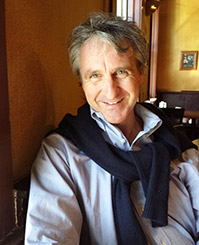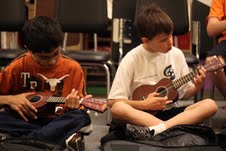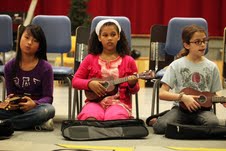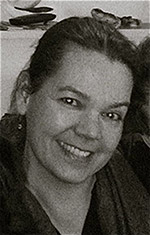Educator Conversations: Jazz at Lincoln Center Orchestra with Wynton Marsalis
Editor’s note: This post is a part of a series of conversations between educators in the K-12 community. Educators will offer suggestions and answer questions about integrating UMS School Day Performances or the arts into classroom curriculum, as well as share advice on organizing a field trip to UMS. To volunteer to be a Teacher Lobby Moderator e-mail umsyouth@umich.edu. Or, check out other Educator Conversations.
This week’s questions:
- What does Jazz music have in common with the music of Mozart and Haydn?
- How does Jazz music reflect the values of African-American culture from which it came?
- How do you find yourself improvising in your life?
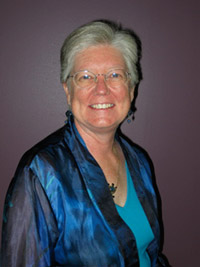 This week’s moderator: Linda Jones. Linda has taught music, math and media in the Ypsilanti Schools from 1999 to 2012. She is currently director of the Ann Arbor Civic Chorus. She has taught jazz history, composition, improvisation and performance as well as acting and creative movement at the elementary level and collaborated with bassist Paul Keller, drummer Sean Dobbins, and pianist Ellen Rowe. She has training as an Orff Music Educator and currently serves as Treasurer to the Greater Detroit Orff Schulwerk Association. She has presented workshops on Jazz improvisation and Composition through Garage Band.
This week’s moderator: Linda Jones. Linda has taught music, math and media in the Ypsilanti Schools from 1999 to 2012. She is currently director of the Ann Arbor Civic Chorus. She has taught jazz history, composition, improvisation and performance as well as acting and creative movement at the elementary level and collaborated with bassist Paul Keller, drummer Sean Dobbins, and pianist Ellen Rowe. She has training as an Orff Music Educator and currently serves as Treasurer to the Greater Detroit Orff Schulwerk Association. She has presented workshops on Jazz improvisation and Composition through Garage Band.
Q: What does Jazz music have in common with the music of Mozart and Haydn?
They both use western harmonic progressions, they both use the same instruments, especially percussion, winds and brass and bass violins. They both have soloists and ensembles. Improvisation is at the heart of Jazz and traditionally there was also improvisation in Baroque performances.
What else can you add to this list?
Q: How does Jazz music reflect the values of African-American culture from which it came?
Everyone has a voice and contributes equally to the ensemble.
Everyone has a chance to shine and show their individual talent.
Collaboration is very important.
Lyrics reflect the reality of life, the loves and struggles, the hope and the suffering.
Talent is mentored and held to a high standard.
Rhythm is the basis of music that cooks, this rhythm flows through all of African-American life.
What else would you include in this list?
Q: How do you find yourself improvising in your life?
I find that teaching is filled with chances to improvise. Lesson plans are only an outline, the craft is in fitting those plans with the needs of the learners present on that day. Any time I am leading a choral rehearsal, I am improvising wildly as I find ways to help the choir improve. Driving also presents plenty of chances to improvise, especially if different routes are possible to get to the destination.
How do you improvise?
Do you have questions or comments for Linda about his approach to this performance or about teaching through performance more broadly? Share your responses or questions in the comments section below.
Educator Conversations: Compagnie Käfig
Editor’s note: This post is a part of a series of conversations between educators in the K-12 community. Educators will offer suggestions and answer questions about integrating UMS School Day Performances or the arts into classroom curriculum, as well as share advice on organizing a field trip to UMS. To volunteer to be a Teacher Lobby Moderator e-mail umsyouth@umich.edu. Or, check out other Educator Conversations.
This week’s questions:
- I want my students to attend an event sponsored by UMS. How can I afford travel expenses?
- I want my all of my students to attend at UMS performance, how can I afford the cost of so many tickets?
- Why dance?
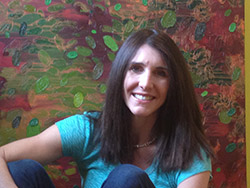 This week’s moderator: Dianne Dudley. Dianne is a Physical Educator for the Ann Arbor Public Schools at Carpenter Elementary. She is the director of the Community High School all-city dance company, Dance Body. She enjoys an active lifestyle with her husband and their four children. She is passionate about creating opportunities for all children to be active. She teaches the free parent/child Dancing Babies creative movement classes for the Ann Arbor Public Library and is a volunteer rec. & ed. coach.
This week’s moderator: Dianne Dudley. Dianne is a Physical Educator for the Ann Arbor Public Schools at Carpenter Elementary. She is the director of the Community High School all-city dance company, Dance Body. She enjoys an active lifestyle with her husband and their four children. She is passionate about creating opportunities for all children to be active. She teaches the free parent/child Dancing Babies creative movement classes for the Ann Arbor Public Library and is a volunteer rec. & ed. coach.
Q: I want my students to attend an event sponsored by UMS or another organization. How can I afford travel expenses?
Community High School was awarded a $350 grant from Michigan Youth Arts (MYA). The all-city dance company will reach out to middle school step teams to attend a University of Michigan Freshman Dance Touring Company performance together during Semester 2. This grant provides an opportunity for more than 60 middle school and high school students to experience a collegiate dance program and performance.
The Michigan Youth Arts’ Arts & Culture Trek Grant program offers grants of up to $500 to Michigan K-12 schools for the transportation cost of an arts and culture field trip. Educators can choose from a list of more than 150 arts and cultural institutions that offer educational programming, exhibits and performances outside the classroom, which enhance the arts and humanities curriculum. The list of available online grants and their due dates for submission can be found on the MYA website.
Q: I want all of my students to be able to attend a UMS performance. How can I afford the cost for so many tickets?
The UMS School Day Performances are offered at a discounted rate for K-12 students. At Community High School, we work with our school PTO to purchase tickets for the entire student body to attend performances together. Our staff and our PTO are committed to providing opportunities to support the Common Core Standards. UMS provides materials for each performance to connect the show to our classroom curriculum. Our teachers use the materials to help facilitate meaningful student engagement before, during, and after the performance.
The UMS Youth Education program includes daytime School Day Performances subsidized for schools, and also Teacher Workshops that energize teaching and learning practices, In-School Visits by performing and teaching artists, and Curriculum Resources to help make direct connections between UMS artists and the classroom.
Q: Why Dance?
I want all of my students to be active so that they can appreciate the physical and mental health benefits of exercise. Dancing is good exercise and a fun way to keep fit. In addition to learning new choreography and dance technique, students work hard throughout the semester to increase their cardiovascular fitness, muscular strength and flexibility. They learn to set realistic goals and learn how to achieve their personal goals. Dance is a great way to raise endorphin and serotonin levels and reduce cortisol levels naturally. I include creative movement and music to all of the lessons I teach at the elementary level. I believe that dancing is a tool that can be used to help bridge our achievement gap. Students bring their own style of dance and experience to the classroom. This can be influenced by their out-of-school opportunities, family and culture. We value, learn, and appreciate dance through every student.
February 14, the Compagnie Käfig modern dance performance will be an excellent field trip opportunity to witness the breath-taking fitness skill-set required to perform with jaw-dropping artistry. This physically demanding dance performance promises a thrilling combination of hip-hop, capoeira dance styles, samba, and acrobatic skills. I will also encourage my students to join dancers from Compagnie Käfig at a free You Can Dance session for an exploration of the company’s movement style on February 13 at the Ann Arbor YMCA.
Do you have questions or comments for Diane about his approach to this performance or about teaching through performance more broadly? Share your responses or questions in the comments section below.
Educator Conversations: One Night in Bamako
Editor’s note: This post is a part of a series of conversations between educators in the K-12 community. Educators will offer suggestions and answer questions about integrating UMS School Day Performances or the arts into classroom curriculum, as well as share advice on organizing a field trip to UMS. To volunteer to be a Teacher Lobby Moderator e-mail umsyouth@umich.edu. Or, check out other Educator Conversations.
This week’s questions:
- Who are these two artists, Bassekou Kouyaté and Ngoni Ba?
- How should I prepare my class for the performance?
- Bamako? What? Where? And who cares?
- Isn’t taking a class on a field trip too much trouble?
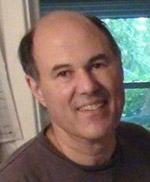 This week’s moderator: Jeff Gaynor. Jeff has been teaching for 35+ years, 20 years at Elementary, and the last 15+ at Clague Middle School, where he teaches Math and Social Studies. He integrates music and art into the curriculum, often prior to field trips, or by bringing guest artists in his classroom. Jeff is on the UMS Teacher Insight Committee has an interest in classical, jazz and world music. He has participated in month-long teacher study trips to Belize, Turkey and South Africa.
This week’s moderator: Jeff Gaynor. Jeff has been teaching for 35+ years, 20 years at Elementary, and the last 15+ at Clague Middle School, where he teaches Math and Social Studies. He integrates music and art into the curriculum, often prior to field trips, or by bringing guest artists in his classroom. Jeff is on the UMS Teacher Insight Committee has an interest in classical, jazz and world music. He has participated in month-long teacher study trips to Belize, Turkey and South Africa.
Q: Who are these two artists: Bassekou Kouyaté and Ngoni Ba?
Ha – this was my first question – and I can save you the same embarrassment. Bassekou Kouyaté is the lead musician. He plays an ancient traditional stringed instrument, like a lute, but he has also modernized it in amazing ways. This instrument is called the ‘ngoni.’ “Ngoni Ba” is the name of the band he leads. Check them out.
Q: How should I prepare my class for the performance?
It’s important that students look forward to the trip with anticipation. The level of academic preparation depends on the grade, subject, and how much time you can spend (pressing issue, I know). At a minimum, I go through the UMS Learning Guide and choose 1 or 2 activities to do with my students. Also very helpful, especially with unusual instruments or genres, is to play audio or video clips in class, and have a discussion to focus attention on how this music is alike or different from other music they have heard.
You can find videos on YouTube, and the Guide has more suggestions. Seeing or listening to the music in your classroom isn’t the real thing, though curiously, the appreciation for the live performance will be increased if students have seen the performer before hand, if on a screen. At a minimum go to the UMS web page and click on “Listen & Learn.”
Of course, the more curriculum connections you make, the more students will take out of the live performance, which leads us to:
Q: Bamako? What? Where? And who cares?
“‘I mean, what is music itself? Music is everywhere, every day. If you’re gonna genuinely do that, you prohibit all sound because music is in language, it’s in everything. It’s totally abhorrent to any musician to be told they can’t play music… It’s a very particular interpretation of the Koran that prohibits all music,’ said Damon Albarn, an Africa Express co-founder.”
Quote from BBC News.
And suddenly, music is more than just music. And Bamako, the capital of Mali, in the horn of Africa, is more than some far away place. And we are teachers – it is our job to show the commonalities and the uniqueness of people in all parts of the globe.
Explore geography – with a map of West Africa, and a map of Mali, point out the the capital of Bamako, the fabled city of Timbuktu (Tombouctou), the Niger River, and the seven countries that border Mali. Find images of these places.
Read folk tales from Mali (or West Africa) as folk tales are universal and also particular. Point out that Bassekou Kouyaté is a griot – a historian and storyteller, through his music.
Most of the northern tier of Africa is heavily Muslim, as is Mali. This is part of their culture and influences the music. Islam is one of the five world religions covered in the Ann Arbor middle school social studies curriculum and may be integrated during the study of Islam or the Middle East or Northern Africa.
The quote that led this section was in response to a crisis in Mali during which Islamic fundamentalists took control of the northern part of the country. France (Mali was a French colony until 1960) then intervened militarily. This is a vital area for research with parallels and ramifications throughout the region.
Q: Isn’t taking a class on a field trip too much trouble?
No! It does take preparation but the benefits far outweigh the effort. And it will be an experience your students will remember for years and link to their classroom learning.
As an elementary teacher, and now middle school social studies teacher, I feel it is eminently important to help students link classroom experiences to the world around them. Reading about a country, or culture, or listening to a CD is one thing; attending a live concert is a visceral experience that brings learning to another level. This music may be different, but music is universal.
UMS keeps the cost of their School Day performances low. As I teach in Ann Arbor, I also choose to have my students travel on the City Bus – a $1.50 round trip, with the benefit that they get more real life experiences. I ask parents to pay the cost (under $10) or what they can, and the School PTSO makes up the difference.
Check out the AATA website for route maps and schedules. You do not need to contact them ahead of time. Do have students go to the back of the bus while you pay the driver for everyone. Do not have each student pay his or her own fare as it takes much too long.
I prepare my class not only for the concert but for taking the bus and walking through city streets: how to wait for and behave on the bus, how to leave space on the sidewalk to allow other pedestrians to pass, how to cross the street – all real life skills that they take seriously. They understand they are now off school property and the expectations are obligatory, not arbitrary. Of course I also prepare them to be good audience members, referring to the UMS Learning Guide for valuable reminders.
In fact the Learning Guide has important and worthwhile resources for pre- and post-concert links, resources and activities. Do take the time to read through it.
Do you have questions or comments for Jeff about his approach to this performance or about teaching through performance more broadly? Share your responses or questions in the comments section below.
Educator Conversations: Pedrito Martinez Group
Editor’s note: This post is a part of a series of conversations between educators in the K-12 community. Educators will offer suggestions and answer questions about integrating UMS School Day Performances or the arts into classroom curriculum, as well as share advice on organizing a field trip to UMS. To volunteer to be a Teacher Lobby Moderator e-mail umsyouth@umich.edu. Or, check out other Educator Conversations.
This week’s questions:
- How does a teacher prepare students for a concert of Cuban music?
- How does an educator integrate this UMS performance into his or her classroom curriculum?
- What are 3 things I can do in a short time frame to make this a meaningful performance for my students?
This week’s moderator: Dan Tolly. Dan is a music educator in the Ann Arbor Public Schools.
Q: How does a teacher prepare students to attend a concert of Cuban music?
My approach to any topic I bring into my classroom is the same; as author Richard Peck says, “it’s all about the story.” In this case, it is important to make connections not just to the music, but also the culture and the artist(s). The “story” is what the students will connect with intellectually, emotionally; it has to have purpose and meaning. If there’s not something in any story that deepens their understanding of the world and is worth remembering for the rest of their lives, then it’s not worth the students’ time. Of course, this is rarely the case, unless a teacher doesn’t take time to research. UMS bringing the Pedrito Martinez Group to Ann Arbor offers area educators a great chance to meaningfully enrich their students’ lives.
A good place to start is with the artist’s biography, to learn his/her personal story and musical and intellectual influences. Pedrito Martinez was born in Havana, Cuba, in 1973. According to his website, he began his musical career at age 11. This is an age when our students begin taking instrumental music in school, so it’s something the students can relate to – envisioning the musician at that stage in life. Finding some documentary film clips on Cuba and Cuban music will help to introduce the students to the sights and sounds that influenced Pedrito. There are also numerous music videos available of the group.
Since Pedrito is fairly young, it is hard to find visual materials on his life (he is included in Calle 54, a documentary of Latin Jazz). To help tell the story of life in Cuba for musicians, the movie For Love of Country (the Arturo Sandoval story) is a great resource, and helps connect the music of Cuba to American Jazz through the connection of Dizzy Gillespie and Arturo. It’s fun to make connections to the artist and those who influenced him, or whose music he enjoys.
While Pedrito is not a household name here, he has recorded with and toured with some names your students will recognize: Wynton Marsalis, Paul Simon, and Paquito D’Rivera. He now lives in New York City (Manhattan) and the Pedrito Martinez Group generally plays three nights a week there. Tie-ins to these artists and their music can offer a nice segue to how musicians collaborate across cultures. In his weekly sets, he often plays his own arrangements of “I’ll Be There” by the Jackson Five, and Led Zeppelin’s “Traveling Riverside Blues,” as well as Latin Jazz pieces, ballads, and original compositions by Pedrito.
Q: How does an educator integrate this UMS performance into his or her classroom curriculum?
As mentioned above, if you weave a story around the performer, you can create meaningful connections to the broader curriculum of your classroom. Tying social studies/geography lessons to the performance can be done in two obvious ways: learning about Cuba, and more broadly about the geography of the African diaspora. Where are the countries located, who lives there, where did they come from? What are the economies based on, how do people live, what types of music do they enjoy (both traditional and contemporary), what is the political climate like? How are they governed? How does this compare to the core democratic values we learn about in our curriculum? I have found that telling the story of Cuban musicians’ lives and their defection to the United States helps to reinforce for our students just how important the rights we take for granted truly are.
Q: What are 3 things I can do in a short time frame to make this a meaningful performance for my students?
1. Purchase the debut album from the Pedrito Martinez Group (or begin by listening to the album on a streaming service like Spotify – embedded below). Play it for the students, and introduce them to the polyrhythms, so they’re familiar with the music and have something to listen for during the performance. Play the video clips from the group’s website.
2. Give your students some biographical information about Pedrito Martinez and the other musicians in the group – Alvaro Benavides (bassist, Venezuelan, Berklee-trained); Jhair Sala (percussionist, Peruvian, came to US to study with Pedrito); Ariacne Trujillo (pianist, vocalist, attended top Cuban conservatory).
3. Make connections to other composers/musicians that you may be covering with your students – Wynton Marsalis, Jackson Five, Led Zeppelin, Paul Simon, Quincy Jones. Have fun making connections through the music. Make at least one connection through geography, social studies, or literature.
Enjoy learning along with your students!
Do you have questions or comments for Dan about his approach to this performance or about teaching through performance more broadly? Share your responses or questions in the comments section below.
Daniel D. Tolly is a music educator whose passion and unique approach to teaching have been recognized with several awards, among them the American Historical Association’s Beveridge Family Teaching Prize, for excellence and innovation in K-12 history teaching; the University of Michigan University Musical Society’s Teacher of the Year; and earlier in his career, the National Association of Jazz Educators’ Director of the Year Award at the Wichita Jazz Festival. Dan has received several district-level teaching awards, and received multiple nominations for the new Grammy award for teachers in 2013. Dan currently teaches music in the Ann Arbor Public Schools, and is involved as master teacher with the NEH-funded Banner MomentsTeacher Institute. Dan is also a lead teacher and collaborator with a University of Michigan/El Sistema pilot program. His education includes graduate studies at the University of North Texas and the University of Michigan.
Educator Conversations: Brooklyn Rider
Editor’s note: This post is a part of a series of conversations between educators in the K-12 community. Educators will offer suggestions and answer questions about integrating UMS School Day Performances or the arts into classroom curriculum, as well as share advice on organizing a field trip to UMS. To volunteer to be a Teacher Lobby Moderator e-mail umsyouth@umich.edu. See other Educator Conversations here.
This week’s questions:
- What does “Brooklyn Rider” mean?
- How does a group like Brooklyn Rider learn to play different genres of music convincingly?
- What are some tips for listening to string quartet music?
This week’s moderator: Emily Barkakati is an Ann Arbor-based violinist, community educator, and teaching artist.
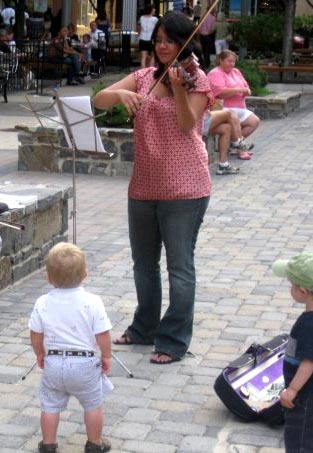 Emily is an Ann Arbor-based violinist, community educator, and teaching artist. She plays with the Michigan Opera Theatre and the Ann Arbor Symphony, organizes events for the Medical Arts Program, runs workshops, and teaches kids how to coordinate their finger hands with their bow arms. She loves crafting, cooking, and learning, and spends a lot of time with her husband and their emotionally dysfunctional cat.
Emily is an Ann Arbor-based violinist, community educator, and teaching artist. She plays with the Michigan Opera Theatre and the Ann Arbor Symphony, organizes events for the Medical Arts Program, runs workshops, and teaches kids how to coordinate their finger hands with their bow arms. She loves crafting, cooking, and learning, and spends a lot of time with her husband and their emotionally dysfunctional cat.
Q: What does “Brooklyn Rider” mean?
Brooklyn Rider’s name is a combination of inspiration from Der Blau Reiter (The Blue Rider) and the borough of Brooklyn in New York City. Der Blau Reiter was a pre WWI Munich-based artistic collective with members such as artist Vassily Kandinsky and composer Arnold Schoenberg. Brooklyn is the place the quartet considers home. The name “Brooklyn Rider” is meant to represent the collaborative spirit of eclectic art-making, both similar to what was found in Der Blau Reiter and in the rich cultural array found in Brooklyn, New York.
Whether it’s the title of a book, work of art, piece of music, or even historical event, there is often a lot that can be derived from something’s name. One of the many ways that students can explore this idea is through the analysis of their own names. For instance:
- What is the etymology of your first name? What about your last name?
- Were you named after anyone?
- Is there a cultural significance to your name? For instance, my last name “Barkakati” comes from my Assamese heritage, and I’ve been told by older relatives that based on traditional Indian naming conventions, our family would have historically been writers.
- Is there a nickname you prefer to go by? What do you think makes it a better representation of your personality?
- What if you could change your name? What would you pick and why?
Students can then use these questions to explore and gain ownership over their personal identities. This kind of exercise could also be expanded into an artistic activity, such as creating a work of art to represent one’s name.
Q: How does a group like Brooklyn Rider learn to play different genres of music convincingly?
Although I can’t speak for Brooklyn Rider, in my own experience I am a predominantly classically trained musician who only started dabbling with improvisation and cross-genre work only in the past few years. The first step I took in my preparation was to simply listen to a lot of music. This is a similar process to learning to write in different styles. Reading a wide variety of genres and authors expands your vocabulary and stylistic knowledge. In the same way, listening to a wide variety of music expands your aural vocabulary. That way when you start playing, you might not know the technical adjustments to achieve the correct sound, but you at least have a mental sound to strive toward.
For me, the most difficult part of jumping into new genres of music was getting over the fear of making mistakes. When I began learning to improvise, a friend of mine gave me the following tips to help me get comfortable:
- Pick a song that you know well.
- Play along with a recording of the song by ear.
- Play along with the recording again, but this time start adding some embellishments.
- Write down some new melodies that would fit into the song. Try playing them on top of the recording.
- Start making up some new melodies on the spot when playing with the recording.
- Remember that there is no such thing as a wrong note! If you play a note that sounds wrong, just turn it into a grace note or an embellishment.
It was important for me to build from my preexisting knowledge in order to gain confidence in my abilities. It also helped tremendously that I had friends who created a safe environment for me to experiment and to receive constructive feedback. The same process of building knowledge in stages, also known as scaffolding, is useful for learning any new genre.
Q: What are some tips for listening to string quartet music?
The key to listening to unfamiliar string quartet music, or any type of complex music, is active listening (as opposed to passive listening). One of the joys of complex music is that there are so many layers – you can listen to a piece many times in many different ways, and always find new exciting elements. At the same time, these many layers are exactly what can also make complex music seem overwhelming. Although different people have different approaches, the key for me is to remain open-minded and allow myself to react in the moment to what is happening. Below are some of the things I think about when listening to unfamiliar music for the first time.
- What are some adjectives that come to mind on my first hearing of the piece?
- Are there any particular melodies that stick out to me? Did I hear them more than once?
- Did the piece remind me of anything that I’ve heard before? Did it invoke any memories or mental images?
- What did I like the most about the piece?
- Is there anything about the piece that I found confusing? What about it was confusing? What are some ways that I can try approaching that section differently to better understand it?
While some believe that it is necessary to research new music in advance in order to understand it, I do not think that this is always the case. I usually prefer to explore my impressions first and then research after. This way my reactions to the piece aren’t influenced by pre-existing interpretations. However, keep in mind that this is just one of many ways to explore new music.
What do you think? Share your responses or questions in the comments section below.
Educator Conversations: Ukulele Orchestra of Great Britain
Editor’s note: This post is a part of a series of conversations between educators in the K-12 community. Educators will offer suggestions and answer questions about integrating UMS School Day Performances or the arts into classroom curriculum, as well as share advice on organizing a field trip to UMS. To volunteer to be a Teacher Lobby Moderator e-mail umsyouth@umich.edu. See other Educator Conversations here.
This week, our moderator answers frequently asked questions about teaching ukulele:
- Why ukulele?
- How did you purchase a class set of ukuleles?
- What kind of strings do you use?
- Do you let students take instruments home?
- What do you learn?
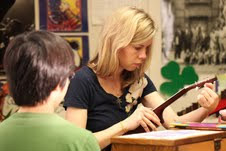 This week’s moderator: Katie Ryan. Katie is a proud graduate of the University of Michigan and Loyola University of New Orleans. Katie began teaching music in the Ann Arbor Public Schools in 1997 and her musical upbringing included experiences in piano, choir, madrigals, concert band, jazz band, musical theater, rehearsal and concert accompanying. She loves bringing a variety of musical experiences to her students at Angell Elementary School in Ann Arbor, Michigan, and hopes that their musical development will help them become life long enthusiasts of music.
This week’s moderator: Katie Ryan. Katie is a proud graduate of the University of Michigan and Loyola University of New Orleans. Katie began teaching music in the Ann Arbor Public Schools in 1997 and her musical upbringing included experiences in piano, choir, madrigals, concert band, jazz band, musical theater, rehearsal and concert accompanying. She loves bringing a variety of musical experiences to her students at Angell Elementary School in Ann Arbor, Michigan, and hopes that their musical development will help them become life long enthusiasts of music.
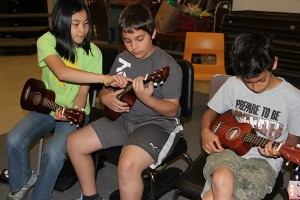
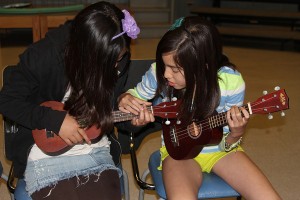
Photos: Students play ukueleles in Katie’s class.
Q: Why ukulele?
A: I’ve always enjoyed teaching recorder to students in third and fourth grades at my school. Because I work with many multi-age classes, I teach this unit every other year so I do not repeat units for students. For many children, the application of musical skills to instrument playing is extremely enjoyable. It’s satisfying for all to see everything come together in this process. In 2011, the Scientific American magazine published a series of articles about the exciting new research linking brain development in young people to experience playing instruments. Not all connections are understood at this point in time, but clearly this experience is powerful for young minds, even in ways that are not immediately evident.
I considered how wonderful it would be for students to have experience playing instruments over three years of their elementary school career, two years with me in vocal/general music and one year in our fifth grade instrumental music program. I reflected back to my own experiences playing ukulele in elementary school. I did research and found this is a common experience for students in Canada and the United Kingdom. I loved the idea that the soprano ukulele is the perfect size for students and that students can sing while playing it. The instrument is capable of playing melodies or chords, which is exciting. Teaching ukulele would lend a better opportunity to teach chord structure, harmonic progressions and form. I also considered that not all of my students will play in band/orchestra or sing in choir when they leave my school, but perhaps they might find some pleasure in playing the ukulele and this is may become a musical outlet for them as they go about their lives after elementary school.
Q: How did you purchase a class set of ukuleles?
A: I visited many of the local music stores in here in Ann Arbor, Michigan. I asked a lot of questions about sound quality and durability. I wanted something that would be a high quality instrument, produce a lovely sound and would hold up to multiple players. Because I planned to buy 25 + instruments, the music store offered a bulk discount, which helped bring down the cost significantly. I spoke with the store about thanking them in our school newsletters and my plans to direct families to them if students chose to purchase an instrument of their own. I believe our community patronized their business quite a bit, especially around the holidays.
After researching how much money I would need, I began looking for grants. Luckily, I live in a community where we have organizations such as the Ann Arbor Educational Foundation. It is an extremely generous organization. I wrote a grant for the instruments as well as soft-sided cases in which to store the instruments to protect the investment. The grant was approved and I was able to purchase most of the instruments. Our school PTO sponsored the purchase of the remaining instruments. I am extremely fortunate.
If you don’t live in a community that has an organization such as these, I’ve had many colleagues and friends recommend organizations such as Donor’s Choose and Adopt a Classroom. See these websites for more information:
http://www.adoptaclassroom.org/
Q: What kind of strings do you use?
A: The folks at my local music store recommended Aquila synthetic strings. They produce a warm tone and are easy to play. They have held up well to use by multiple players. The strings are color coded to make changing strings less challenging.
Q: Do you let students take instruments home?
A: No. Because I have multiple classes using the instruments, I’ve decided instruments must remain at school. I have opened my room up to students who wish to play more often during lunch times. I also structure the classes so that all students have an opportunity to practice/play/discover while I am working with individual students on tuning.
Q: What do you learn?
A: The unit was very successful. “Ukulele fever” was rampant across the school and I am definitely excited to teach the unit again next year. Currently, I will hold a ukulele lunch club for those who would like to continue playing this year. I learned a lot in the process:
I learned students would need to build up calluses, so I incorporated lots of breaks and “air ukulele” playing into our routines as students built up resilience in their finger tips.
Unlike recorders, ukuleles need to be tuned! I learned taking some time to help students with tuning at the beginning of class periods gives others an opportunity to practice. Usually, I would tune the instruments for the first group of students using the instruments in any given day. Classes following would be tuned on a “as needed” basis. Although I had to move quickly, this brief one on one interaction with students was a good relationship builder and something we don’t get to experience often enough when we see hundreds of students per day. Discussion often centered on if strings sounded too high or too low and the new G7 chord, but sports teams, pets, loose teeth and weekend plans were discussed as well, however briefly. I’ve found students are willing to work hard when they know you care about them.
I learned many songs can be sung/played with only two or three chords. There are lots of lists of songs and chords used for ukulele playing floating on the internet. My students became fairly fluent at playing chords used in C Major: C M, F M, G7 and a minor.
I learned how good it is to talk with students about the challenge of doing something new that does not come easily at first. Switching from one chord to the next requires an incredible amount of anticipation, planning, coordination and determination. Many students may feel frustrated at first. I find it’s important to acknowledge this and that learning in general can be hard work. As students find success, it’s all the sweeter.
Please feel free to contact me if you have any further questions! Happy strumming!
Do you have questions or comments for Katie or about teaching through ukuleles? Share your responses or questions in the comments section below.
New! Educator Conversations
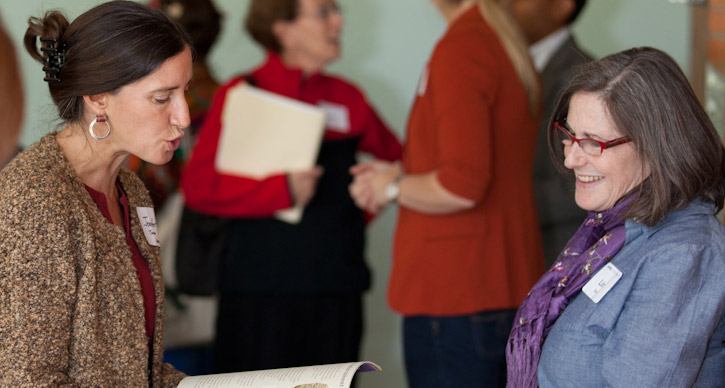
Photo: Emerson School educator Jennifer Tanau and UMS Advisory Committee member Linda Spector at a UMS reception for teachers. Photo by Mark Gjukich Photography.
This season, look for Educator Conversations on UMS Lobby.
Educators will offer suggestions and answer questions about integrating UMS School Day Performances or the arts into classroom curriculum, as well as share advice on organizing a field trip to UMS. To volunteer to be a Teacher Lobby Moderator e-mail umsyouth@umich.edu.
Educator Conversations will take place around UMS School Day Performances. As soon as the conversations are live, we’ll include a link on this page.
- Hubbard Street Dance Chicago with Melissa Poli (Performance September 27)
- Ukulele Orchestra of Great Britain with Katie Ryan (Performance November 12)
- Brooklyn Rider with Emily Barkakati (Performance November 25)
- One Night in Bamako with Jeff Gaynor (Performance February 7)
- Compagnie Käfig with Dianne Dudley (Performance February 13)
- Pedrito Martinez Group with Dan Tolly (Performance March 14)
- Jazz at Lincoln Center Orchestra with Wynton Marsalis with Linda Jones (Performance March 31)
Share you questions or comments below.
Educator Conversations: Hubbard Street Dance Chicago
Editor’s note: This post is a part of a series of conversations between educators in the K-12 community. Educators will offer suggestions and answer questions about integrating UMS School Day Performances or the arts into classroom curriculum, as well as share advice on organizing a field trip to UMS. To volunteer to be a Teacher Lobby Moderator e-mail umsyouth@umich.edu. See other Educator Conversations here.
This week’s questions:
- How does a dance teacher prepare her students to see a UMS dance performance?
- How would I create a choreographic project inspired by Hubbard Street’s “One Thousand Pieces”?
- What are suggestions for cheap and quick (not fast food) Ann Arbor restaurants that will accommodate large groups?
This week’s moderator: Melissa Poli (Dance, Yoga, and Physical Education Teacher at Farmington High School)
Hi, my name is Melissa Poli, and I live in Ann Arbor with my husband, Andy, 14 year old daughter, Gabrielle and our part-time dog, Mina. I work at Farmington High School where I get to teach my two passions, dance and yoga. In my spare time, I attend dance concerts and festivals and lots of amazing yoga retreats in beautiful places with my family. And it’s probably obvious that my favorite quote is, “Let the beauty of what you love be what you do.” (Rumi).
How does a dance teacher prepare her students to see a UMS dance performance?
Lots of pre-performance discussions!!! This is a “must” in order to gain an appreciation and enthusiasm for the artists and their work. Just refer to ums.org for lots of background information and video links to guide your discussions. After viewing an excerpt from one or more of the dances, I then ask the following questions. These are referred to as “The 4 Step Critique”
- What do you see?
- How is the work organized?
- What does the dance communicate?
- How effective is the dance work?
While watching the performance (notebook in hand) students jot down the answers to these questions. We actually practice writing without looking down (so we don’t miss anything). This experience is so valuable in terms of recognizing the process of creating dances. If the overall dance works in their opinion or even if it doesn’t, at least they will be able to articulate why!
How would I create a choreographic project inspired by Hubbard Street’s One Thousand Pieces?
Or, if given the same task as choreographer Alejandro Cerrudo, how would we go about it? Would we make the same decisions? How would we interpret Marc Chagall’s American Windows?
When Alejandro Cerrudo was asked, How are you responding to Chagall’s America Windows? He replied, “The evening is inspired by the windows, but I’m not making them in dance. I might give you another perspective. You might look at the windows in a different way, after you see my piece. The windows aren’t about America. They’re about character, painting, cultural freedom, celebration.”
Related, here is my example America Windows choreography project. Students will divide into small groups and choose one panel to use as inspiration for their choreographic studies.
Each group will answer the following questions (look familiar?):
- What do you see? List everything, including the visual arts elements of line, shape, form, value/shading, texture, space, color.
- How is the work organized?
- What does the art communicate?
Students will then create dances based on the answers.
What are suggestions for cheap and quick (not fast food) Ann Arbor restaurants that will accommodate large groups?
My favorite place by far has been the Big Boy on Plymouth Road. We get the buffet in order to accommodate everybody. I collect the money ahead of time, including tips, and pay all at once. Call ahead to reserve. Or, If you have enough chaperons, the kids really like dividing up to visit various restaurants near State Street and Liberty Street.
What do you think? Share your responses or questions in the comments section below.


